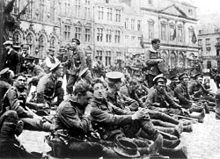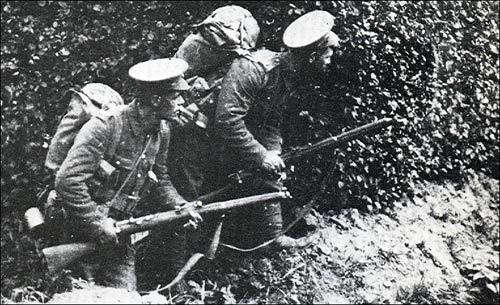The French lose 27,000 on a single day.
The British get in it.
Special to The Great War Project
(22 August) Finally today a century ago, the British join the fight.
It’s been more than three weeks since the British Expeditionary Force set out from Britain to confront the German army in Belgium.
Finally today, the British reach the front at the Belgian town of Mons.
This is “the first serious clash of arms on the Western Front by the British,” reports historian Martin Gilbert. It does not go well for the British.
British artillery cannot match the fire power of the German big guns. British shells fall far short of the German lines.
German shells are tearing up the British. And the German troop strength at Mons far outnumbers the British.
At the same time, British air reconnaissance planes are shot down, also a victim of German artillery.
The French are faring no better.
At the French town of Rossignol French troops are cut to shreds by machine-gun fire. Some two-thousand French soldiers are buried there, who fall victim this day.
Historian Martin Gilbert paints the big picture of the war on the Western Front, this day exactly a century ago. German forces positioned in the center of Belgium total 580,000 troops. Together the French and the British total 336,000. Between them the British can field only 36,000.
German intelligence is far better informed of the forces the Germans are facing than are French and British intelligence. French intelligence underestimates the German troop strength by fifty percent. It is a deadly mistake.
In the first three weeks of the war, French killed and wounded total more than 250,000.
By nightfall, just a single French division suffers losses of 11,000 killed or wounded out of a total troop strength of 15,000.
In total, 27,000 French soldiers are killed on this single day a century ago. According to historian Max Hastings, “the French army suffered casualties on a scale never thereafter in the war surpassed by any nation in a single day.”
In the first three weeks of the war, French killed and wounded total more than 250,000. Writes Hastings, these casualties “dealt the French army a blow from which it never fully recovered – it is remarkable that it recovered at all.”
There’s a canal at Mons, called the Mons-Conde Canal. The British are ordered to entrench and hold the canal. They begin digging in. They use mess kits for the digging. They are not issued shovels. Not yet.



Shocking how quickly industrialized warfare chews through the armies supposedly prepared to fight it. alex chadwick
I know this is off-topic, but this morning, as I drove from Montreal back into the states at the VT border, the CBC reported that today is the 100th anniversary of when the Canadian government interred the Ukranian population. I did a quick online search for information and found this site, linked from the CBC… http://www.infoukes.com/history/internment
Opening paragraphs, “With the outbreak of World War I, the War Measures Act (1914) was implemented as a result of an Order In Council by the Canadian Government. This resulted in the internment of 8,579 “enemy aliens” of which over 5,000 were Ukrainians who had emigrated to Canada from territories under the control of the Austro-Hungarian Empire. It also meant an additional 80,000 individuals (of which the vast majority were Ukrainians) were obliged to register as “enemy aliens” and then required to report to local authorities on a regular basis.
These internees were used to develop Canadian infrastructure as “forced-labourers”. They were used to develop Banff National Park, the logging industry in Northern Ontario & Quebec, the steel mills in Ontario & Nova Scotia, and in the mines in British Columbia, Ontario & Nova Scotia. This infrastructure development program benefited Canadian corporations to such a degree that the internment was carried on for two years after the end of World War I.”
C’est incroyable!